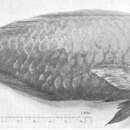Diagnostic Description
provided by Fishbase
This is the only Scarus in which one of the middle dorsal rays of terminal males is produced into a slightly elongate filament. Small juveniles have a distinctive yellow head and striped to mottled body (Ref. 1602).
Life Cycle
provided by Fishbase
Oviparous, distinct pairing during breeding (Ref. 205).
Morphology
provided by Fishbase
Dorsal spines (total): 9; Dorsal soft rays (total): 10; Analspines: 3; Analsoft rays: 9
Trophic Strategy
provided by Fishbase
Occurs inshore (Ref. 75154). Feeds by scraping algae from the substrate (Ref. 26993).
Biology
provided by Fishbase
Often found in large groups (Ref. 90102). Adults usually seen along the reef margin of seaward reefs while juveniles and subadults are found in shallow protected reefs (Ref. 9710). Feeds mainly on algae (Ref. 26993). Occurs to a depth of over 50 m (Ref. 1602). Adults and subadults form groups, juveniles usually solitary (Ref. 9710). Minimum depth of 1 m reported from Ref. 90102.
- Recorder
- Estelita Emily Capuli

